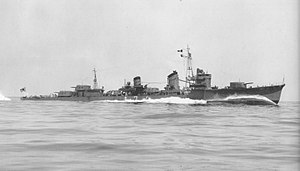Japanese destroyer Nowaki (1940)
 Nowaki underway on 19 April 1941
| |
| History | |
|---|---|
| Name | Nowaki |
| Ordered | 1937 |
| Laid down | 8 November 1939 |
| Launched | 17 September 1940 |
| Commissioned | 28 April 1941 |
| Stricken | 10 January 1945 |
| Fate | Sunk in action, 26 October 1944 |
| General characteristics | |
| Class and type | Template:Sclass- |
| Displacement | 2,490 long tons (2,530 t) |
| Length | 118.5 m (388 ft 9 in) |
| Beam | 10.8 m (35 ft 5 in) |
| Draft | 3.8 m (12 ft 6 in) |
| Speed | 35 knots (40 mph; 65 km/h) |
| Complement | 240 |
| Armament |
|
| Service record | |
| Operations: | Battle off Samar (1944) |
| Victories: |
|
Nowaki (野分, "Fall Gales") was a Template:Sclass- of the Imperial Japanese Navy.
Design and description
The Kagerō class was an enlarged and improved version of the preceding Template:Sclass-. Their crew numbered 240 officers and enlisted men. The ships measured 118.5 meters (388 ft 9 in) overall, with a beam of 10.8 meters (35 ft 5 in) and a draft of 3.76 meters (12 ft 4 in).[1] They displaced 2,065 metric tons (2,032 long tons) at standard load and 2,529 metric tons (2,489 long tons) at deep load.[2] The ships had two Kampon geared steam turbines, each driving one propeller shaft, using steam provided by three Kampon water-tube boilers. The turbines were rated at a total of 52,000 shaft horsepower (39,000 kW) for a designed speed of 35 knots (65 km/h; 40 mph). The ships had a range of 5,000 nautical miles (9,300 km; 5,800 mi) at a speed of 18 knots (33 km/h; 21 mph).[3]
The main armament of the Kagerō class consisted of six Type 3 127-millimeter (5.0 in) guns in three twin-gun turrets, one superfiring pair aft and one turret forward of the superstructure. They were built with four Type 96 25-millimeter (1.0 in) anti-aircraft guns in two twin-gun mounts, but more of these guns were added over the course of the war. The ships were also armed with eight 610-millimeter (24.0 in) torpedo tubes for the oxygen-fueled Type 93 "Long Lance" torpedo in two quadruple traversing mounts; one reload was carried for each tube.[2] Their anti-submarine weapons comprised 16 depth charges.[3]
Construction and career
The destroyer was ordered in 1937. Nowaki was laid down on 8 November 1939 and launched on 17 September 1940. The ship was commissioned into the IJN on 28 April 1941.
Nowaki was initially assigned to Destroyer Division 4 of the Destroyer Squadron 4. At the beginning of World War II, she was engaged as an escort during the invasion of the Philippine Islands and during subsequent operations around Malaya. On 1–4 March, while in company with the cruisers Maya, Atago, Takao, and destroyer Arashi, she was involved in sinking a number of Allied vessels during operations in the Java Sea. On 1 March, Nowaki assisted Arashi in sinking the Dutch motorship Toranja and the British minesweeper Scott Harley, and later that day captured the Dutch steamship Bintoehan. On 2 March, Nowaki assisted in sinking the destroyer HMS Stronghold. On 3 March 1942, Nowaki helped sink the gunboat USS Asheville. On 4 March, Nowaki assisted in sinking the Australian sloop Yarra and the British Motor Minesweeper 51, tanker Francol, and depot ship Anking.
During the Battle of Midway, Nowaki took survivors off the damaged aircraft carrier Akagi and then helped scuttle her with torpedoes. Later that year Nowaki and the remaining destroyers of Destroyer Division 4 were reassigned to Destroyer Squadron 10 based in Truk. For the remainder of 1942 and most of 1943, Nowaki operated in and around the Solomon Islands.
Returning to the Central Pacific after a trip to Japan, Nowaki took part in the Battle of the Philippine Sea. In the Battle off Samar on 25 October 1944, Nowaki took part in the torpedo attack on the U.S. escort carriers and assisted in sinking the destroyer USS Johnston. Later, she removed survivors from the cruiser Chikuma and scuttled her with torpedoes, although recent studies suggests that she only managed to arrive in time to rescue the survivors, as Chikuma herself had sunk beforehand. After being crippled by gunfire from U.S. cruisers on 26 October, she was finished off by torpedoes from USS Owen, 65 miles (105 km) east-southeast of Legaspi (13°0′N 124°54′E / 13.000°N 124.900°E).
See also
Notes
References
- Chesneau, Roger, ed. (1980). Conway's All the World's Fighting Ships 1922–1946. Greenwich, UK: Conway Maritime Press. ISBN 0-85177-146-7.
- Jentschura, Hansgeorg; Jung, Dieter; Mickel, Peter (1977). Warships of the Imperial Japanese Navy, 1869–1945. Annapolis, Maryland: United States Naval Institute. ISBN 0-87021-893-X.
{{cite book}}: Unknown parameter|lastauthoramp=ignored (|name-list-style=suggested) (help) - Whitley, M. J. (1988). Destroyers of World War 2. Annapolis, Maryland: Naval Institute Press. ISBN 0-87021-326-1.
